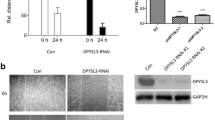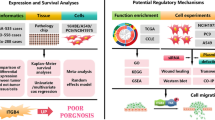Abstract
Lung cancer is one of the leading causes of death in the world. Some tumor events are attributed to an important group of molecules (cadherins and integrins). We evaluated the interactions of cell adhesion molecules in cell lines from lung cancer. Two lung cancer cell lines were nonmetastatic (H358 and H441) and two were metastatic (H1299 and H292). All cell lines were treated with epidermal growth factor (EGF), and Western blot analysis was performed to assess the interactions between these proteins. The bronchoalveolar cells H358 showed the three analyzed proteins: E-cadherin, β-catenin, and p120 catenin. The adenocarcinoma cells H441 did not present p120 catenin, and carcinoma cells did not show E-cadherin (H1299) or p120 catenin (H292). FAK (pTyr925) was dephosphorylated in adenocarcinoma cells H441, absent in carcinoma cells H1299, and upregulated in the other carcinoma cells H292. p130Cas showed no difference when the cell lines were treated with EGF for 30 min; it was absent in the metastatic carcinoma cells H1299. Paxillin was dephosphorylated in adenocarcinoma cells H441 and also absent in other metastatic carcinoma cells H292. Vinculin showed the same results, and talin was downregulated in adenocarcinoma cells H441 when the cells were treated with EGF. Rap1 was downregulated and PYK2 was upregulated in the same cell line. Our data help to comprehend the mechanism involved in cell migration to the blood and metastasis generation. In conclusion, the expression patterns of cell–cell adhesion were not affected by EGF treatment but it affected cell–extracellular matrix adhesion.




Similar content being viewed by others
References
Soria JC, Kim SE, Fayette J, Lantuejoul S, Deutsch E, Hong WK (2003) Chemoprevention of lung cancer. Lancet Oncol 4:659–669
Schiller JH (1998) Lung cancer: therapeutic modalities and cytoprotection. Lung 176:145–164
Sandler AB, Buzaid AC (1992) Lung cancer: a review of current therapeutic modalities. Lung 170:249–265
Dinkel E, Mundinger A, Schopp D, Grosser G, Hauenstein KH (1990) Diagnostic imaging in metastatic lung disease. Lung 168:1129–1136
Spiro SG (1982) The management of lung cancer. Lung 160:141–155
Blackhall F, Malcolm R, Thatcher N (2006) Where next for gefitinib in patients with lung cancer? Lancet Oncol 7:499–507
Greenlee RT, Murray T, Bolden S, Wingo PA (2000) Cancer statistics. CA Cancer J Clin 50:7–30
Delektorskaya VV, Perevoshchikov AG, Golovkov DA, Kushlinski NE (2005) Expression of E-cadherin, β-catenin, and CD-44v 6 cell adhesion molecules in primary tumors and metastases of colorectal adenocarcinoma. Bull Exp Biol Med 139:706–710
Mehlen P, Puisieux A (2006) Metastasis: a question of life or death. Nat Rev Cancer 6:449–458
Forest V, Campos L, Vergnon JM, Cornillon J, Guyotat D (2005) Characterization of the focal adhesion complex in human non-small cell lung cancer cell lines. Anticancer Res 25:4135–4140
Pignatelli M, Vessey CJ (1994) Adhesion molecules: novel molecular tools in tumor pathology. Hum Pathol 25:849–856
Hirata T, Fukuse T, Naiki H, Wada H (2001) Expression of E-cadherin and lymph node metastasis in resected non-small-cell lung cancer. Clin Lung Cancer 3:134–140
Ogekawa T, Pong RC, Li Y, Hsieh JT (2004) The role of cell adhesion molecule in cancer progression and its application in cancer therapy. Acta Biochim Pol 51:445–457
Nawrocki B, Polette M, Hegel JV, Tournier JM, Roy FV, Birembaut P (1998) Cytoplasmic redistribution of E-cadherin–catenin adhesion complex is associated with down-regulated tyrosine phosphorylation of E-cadherin in human bronchopulmonary carcinomas. Am J Pathol 153:1521–1530
Bremmes RM, Veve R, Gabrielson E, Hirsch FR, Baron A, Bemis L, Gemmil RM, Drabkin HA, Franklin WA (2002) High-throughput tissue microarray analysis used to evaluate biology and prognostic significance of the E-cadherin pathway in non-small-cell lung cancer. J Clin Oncol 20:2417–2428
Lu Z, Jiang G, Jensen PB, Hunter T (2001) Epidermal growth factor induced tumor cell invasion and metastasis initiated by dephosphorylation and downregulation of focal adhesion kinase. Mol Cell Biol 21:4016–4031
Wijnhoven BPL, Dinjens WNM, Pignatelli M (2000) E-cadherin–catenin cell–cell adhesion complex and human cancer. Br J Surg 87:992–1005
Pirinen RT, Hirvikoski P, Johanson RT, Hollmen S, Kosma VM (2001) Reduced expression of alpha-catenin, beta-catenin, and gamma-catenin is associated with high cell proliferative activity and poor differentiation in non-small cell lung cancer. J Clin Pathol 54:391–395
Hauck CR, Hsia DA, Schlaepfer DD (2002) The focal adhesion kinase—a regulator of cell migration and invasion. IUBMB Life 53:115–119
Comoglio PM, Boccaccio C, Trusolino L (2003) Interactions between growth factor receptors and adhesion molecules: breaking the rules. Curr Opin Cell Biol 15:565–571
Marcoux N, Vuori K (2005) EGF receptor activity is essential for adhesion-induced stress fiber formation and cofilin phosphorylation. Cell Signal 17:1449–1455
Okegawa T, Li Y, Pong RC, Hsieh JT (2002) Cell adhesion proteins as tumor suppressors. J Urol 167:1836–1843
Nair KS, Naidoo R, Chetty R (2005) Expression of cell adhesion molecules in oesophageal carcinoma and its prognostic value. J Clin Pathol 58:343–351
Acknowledgments
The authors thank the Roche Center for Medical Genomics (RCMG) for financial support.
Conflict of interest
None.
Author information
Authors and Affiliations
Corresponding author
Rights and permissions
About this article
Cite this article
Fonseca, F.L.A., Azzalis, L.A., Feder, D. et al. Adhesion Molecules Affected by Treatment of Lung Cancer Cells with Epidermal Growth Factor. Lung 189, 383–389 (2011). https://doi.org/10.1007/s00408-011-9300-9
Received:
Accepted:
Published:
Issue Date:
DOI: https://doi.org/10.1007/s00408-011-9300-9




